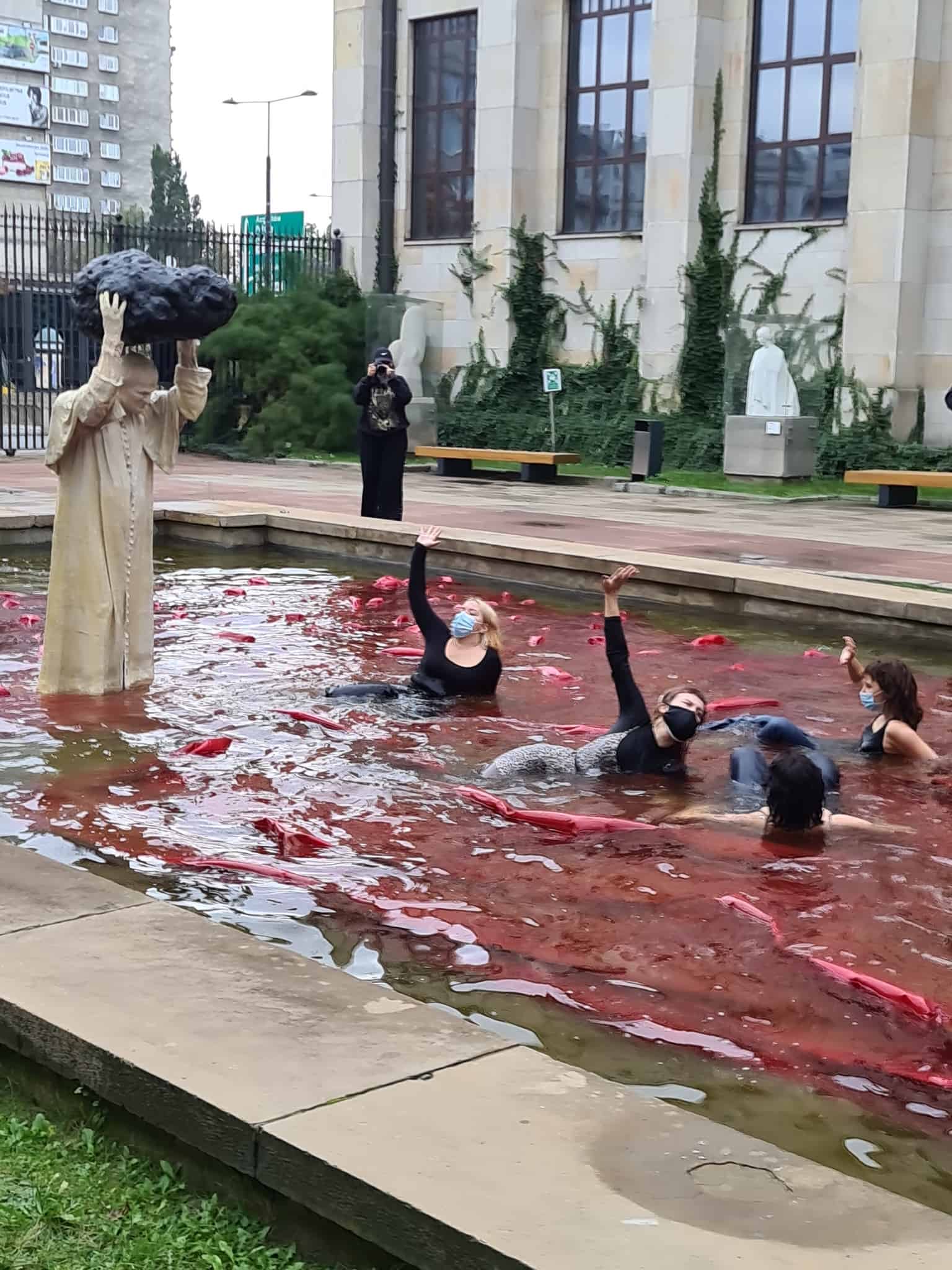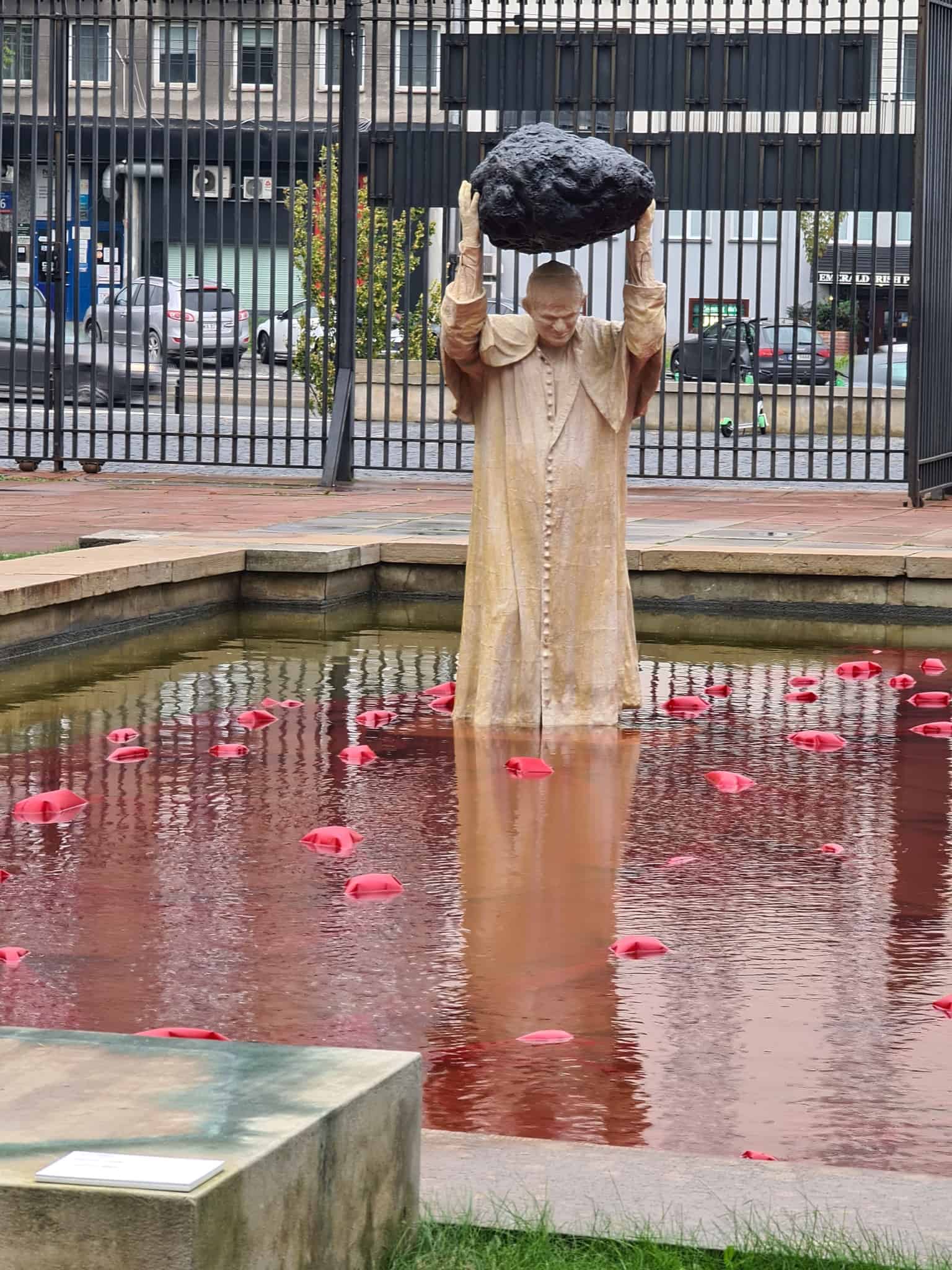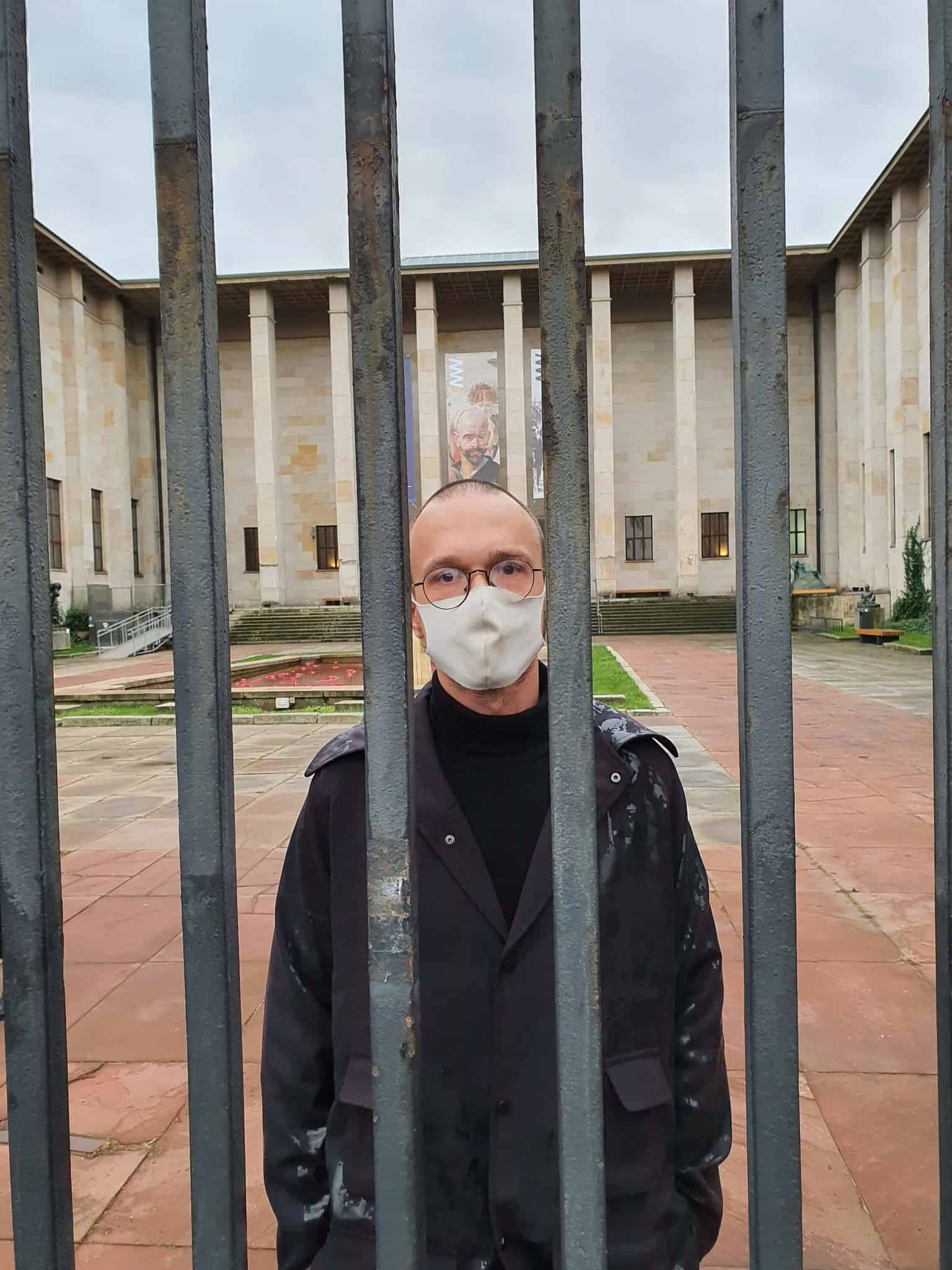The photograph of four women lying in a pond outside of the National Museum in Warsaw went viral on October 23rd, 2020. They were lying directly at the feet of the sculpture of Pope John Paul II holding a boulder over his head. The picture was published during the eruption of nation-wide protests of women’s rights. I discussed the circumstances that lead to this artistic intervention with its two creators and participants: Krzysztof Gonciarz and Ula Jabłońska.

photo: Krzysztof Gonciarz
Artur Wabik: The day after constitutional court heavily restricted abortion rights in Poland, you entered into a dialogue with Jerzy Kalina’s scultpure “Zatrute Źródło” (“Poisoned Well”), located outside of the National Musiem in Warsaw. How did it happen?
Krzysztof Gonciarz: As a matter of fact, we were considering it for a while, basically from the moment the sculpture was unveiled at this spot. What mattered to me personally were the statements made by the artist who implied in one of his interviews that John Paul II throws the rock at communism while red water symbolizes the contemporary iteration of Marxism in the form of LGBT community. It occurred to me that it was a blatant act of aggression by the pope. My intention was to bring this interpretation to the forefront. I thought inserting people in this context would momentarily create an extremely drastic scene. I got in touch with Ula pretty quickly, she was brave enough to jump into the water herself.
Ula Jabłońska: Sure, but I was just one out of five girls.
AW: Five? But there are only four of you in the picture.
KG: Things did not go exactly according to plan, but we will get to that later.
UJ: I agreed to participate in the project immediately after Krzysztof pitched the idea to me. We came to the conclusion that it was a good time to act, when the protests against the constitutional tribunal decision had started. It took us only couple of hours to coordinate the whole thing. I reached these five girls through friends of friends; we did not know each other before. We met for the first time only a few minutes before the action. I mean, they knew each other, but I did not know them at all. They were the ones that got together and arrived as one tight-knit unit.

photo: Krzysztof Gonciarz
AW: Who are these women in the picture then? Are they artists or activists?
UJ: They are more like activists, they engage in numerous initiatives as volunteers. This issue was just particularly close to their heart.
KG: While girls were preparing for the action, my friend and I were already at the museum pretending to be a couple of visitors. Initially, I circled the sculpture wondering about the best angle to take the photograph. The spot I selected was ruled out pretty much immediately by guards blocking access. We stayed in touch on Instagram this whole time to synchronize the operation. I planned to leave the museum right after taking the picture. Because I did not want to be detained, not as much as for legal but for practical reasons; I had a plane to Tokyo in a few hours. If I had been caught, I would not have made my flight.
UJ: We caught a slight delay. I was the only one over the age of eighteen. The girls who came to meet me were only sixteen. They were nice but hard to get in line. We finally did it, yet it was not easy for us to get on the same page.
KG: In the meantime, I was staring at the Egyptian sculpture at the museum’s lobby waiting for the signal. Suddenly, I heard something about a suspicious group of girls outside through a walkie-talkie of one of the security guards. Everything just spiralled afterwards.
UJ: Three security guards appeared nearby in a flash, but they had no idea what to expect. I decided to go ahead with it anyway. Even though one of the girls was caught and could not jump in, but the rest of them did.
KG: There were three other persons by the sculpture taking pictures and recordings in case I could not take this photograph myself. Our group consisted of nine people in total, pretending to be strangers. One of them even had a baby stroller, so we would not raise any suspicions. We were like the Ocean’s Eleven crew, minus two members. Security guards tried to prevent us from taking pictures since they could not get the girls out of the water. They cut off all exits, presumably following the security protocol.
AW: This photograph was posted on your social media just after 5.00 pm while women’s protests were erupting across the country.
KG: Yeah, to some extent it was drowned out by all the media buzz on the first day of massive protests. The photograph itself had a pretty good reach. It was viewed over one million times on my social media channels, though it did not really spark any broader media interest.

Jerzy Kalina’s statue, photo: Krzysztof Gonciarz
AW: I suppose few contemporary works of art have comparable audience reach these days.
KG: If we had orchestrated it two days earlier, we could have initiated a much wider debate. However, we came out of the whole thing pretty much unscathed due to the distractions of the right-wing media. I expected backlash for profanation of the pope’s likeness. In reality, nothing even remotely similar happened.
AW: In what categories do you think about the intervention? Was it an artistic performance or an act of civic activism?
KG: I think both.
UJ: “Artivism” if you will, exactly. Our entrance to the museum itself would be considered an artistic activity without any record. If nobody saw it, the activity would not categorize as activism. For me, the documentation adds an element of activism to it.
AW: I view it mainly in terms of a performative action involving physicality – you had to get into the water, you had to get wet. Do you have any former experience in the similar area, such as theatre or working with a body in a public space?
UJ: I cannot answer on behalf of the rest of the participants since I do not really know them. Nonetheless, I was associated with theatre and acting groups for a while, yes.
KG: Sure, but only as a photographer and filmmaker, someone documenting the performance.
AW: Your appropriation of someone else’s work altered its meaning. Have you done it before? Are these types of subversive practices an essential part of your creative work?
UJ: Not really. Sometimes my paintings or poems allude to the pieces of other artists, but that is it.
KG: I would compare it with an internet meme. This sculpture became a meme very quickly, pretty much the day it was unveiled. People saw it on the internet before. What we did was merely another remix, another meme. Theoretically, you could achieve the same result in Photoshop.
UJ: Only the live-action is much more powerful.
KG: Yes, but at some level it is also the extension of the language of the internet, the way it chewed out this work before us.

Jerzy Kalina’s statue, photo: Krzysztof Gonciarz
AW: In my opinion, the internet lacks gravitas as opposed to a physical act. Krzysztof, it was your first activity of this kind occurring in real life, not on the internet, and by this kind I mean borrowing someone’s artwork and overwriting it with new meanings.
KG: That is right, although the similar logic followed our previous action “Stop the Trucks” which parodied the homophobic statements in public space. The goal was to take some element of reality triggering anxiety and distaste and annihilate it with a meme.
AW: Were you aware of the fact that you add other meanings to the artwork that itself refers to another work?
KG: I was aware of this whole thing with “The Ninth Hour” by Maurizio Cattelan that was exhibited at the Zachęta – National Gallery in 2001. In no way it was our point of departure. The action would have worked regardless of the connection between Kalina’s work and Cattelan’s sculpture. There was no direct correlation between the piece by Cattelan and ours.
AW: This palimpsest is a very interesting idea, meanings overwritten by objects and activities which form some sort of continuity. Do you even remember Cattelan’s installation?
UJ: I was only two years old back then, so I there is no way I could remember it. However, I can’t help it but feel that our work’s reference to Cattelan’s piece is rather redundant. It was not even a blip on our radar. Instead, our intention was to respond to what was happening at this moment in time.
KG: I recall this incident even though I was not dealing with art, back then. The most hilarious part of this whole story was the fact that twenty years ago it was Wojciech Cejrowski who tried to cover the Cattelan’s sculpture with a white sheet. He claimed his goal was to save visitors of Zachęta from revulsion. Cejrowski is like a phantom following me around. We work in the same areas, such as travelling and culture, but our methods are completely at odds with one another. Some people call me the liberal version of Cejrowski.
AW: The exhibition at Zachęta involved a huge scandal, the sculpture was destroyed and Anda Rottenberg, Zachęta’s director, was dismissed. Nowadays we are in a completely different place. Today, refusal to promote catholic and nationalist values might not only cost you a job but rule out a potential candidate for vacancy. What is your perspective on this?
KG: My lack of insight into the actual state of affairs at the National Museum in Warsaw notwithstanding. My intuition tells me to sympathize with this institution somehow, with its employees in particular. I assume there was a recent change in leadership, too.

photo: Krzysztof Gonciarz
AW: That is right, Łukasz Gaweł was designated as the museum’s director for a five-year term on November 15th, 2020. He was the acting director of the museum since December 2019, meaning also at the time of your intervention. Allow me to read out the statement he made regarding the “Poisoned Well”: ‘Like every work of art, this piece allows for a wide variety of interpretations. I encourage you to engage in the topical debate about this work, the role of art in a social climate, freedom of artistic expression, as well as intertextuality of art in general. Furthermore, please refrain from embroiling the museum in ideological disputes that have nothing to do with the freedom of artistic expression.’
UJ: It sounds like the support of dialogue on any subjects but those deemed inconvenient for the institution. Besides, the sculpture gets stripped off its meanings attributed to it by the author himself.
KG: I believe, if we detached this sculpture from the nationalist art upholding the paradigm of fostered patriotism, then it would be much more interesting even in its current form. It could be perceived as a controversial and shocking representation if, let us say, it addressed the vague position of Pope John Paul II on the cover-ups of paedophilia in the Catholic Church. Meanwhile, it derives from the narrative of nationalism, patriotism, and martyrology. On top of that, the execution itself is flawed. No wonder it became a meme. Mockery of a piece filled with pathos gives people satisfaction. It was supposed to be this monumental and serious work of art, but it just did not work out. Perhaps greater ambiguity would tip the scales to its favour.
AW: Do not you wonder why Kalina, who engages in a clearly commemorative art, renders the legacy of John Paul II so relative? According to the artist, the motivation for creating this sculpture was the conviction that “a group of radicals” perpetrating “excesses against religious symbols” has a voice in Poland. How would you comment on this? It seems as if you did exactly what Kalina was so afraid of.
UJ: This sculpture seems like an excess to me. How can you depict pope’s aggression and purport paying homage?
KG: Additionally, there is an abundance of John Paul II monuments without any artistic merit, all around Poland. We exhausted the subject, it is done. I find it surprising how someone even attempts to still address it.
AW: Your performance highlighted how aggressive this sculpture really is. I suppose the sculpture was meant to be viewed as a metaphor. Pope holding a boulder is aiming at something, but we have no idea what it is. You were the ones who materialized the object of pope’s aggression.
UJ: Exactly, human beings are described in Poland as “ideology”, replaced with some abbreviations, symbols, or abstract notions which have no subjectivity. What does it mean that the pope throws a rock at the “Marxist LGBT ideology”? These are people you are talking about, selected social groups, these sixteen-year-old girls included.
KG: We wished to abolish the practice of dehumanizing social communities, as well as a broader metaphor for growing-up and the state of education in Poland. This depiction of John Paul II is unbearable in the face of all this intensity constantly shoved down our throats these days. It is the sign of our times. That is why I titled this picture – “Poland 2020”.
AW: Was the choreography in the pond fully spontaneous?
KG: We wanted to show emotions. The girls had freedom of movement, but we took the poster for “The House That Jack Built” by Lars von Trier as our point of departure.
AW: Krzysztof, your activism extends into other areas, such as documenting events and producing movies based on the investigative journalism. All this while staying in Japan. Tell me, why did you become so involved with the socio-political situation in Poland?
KG: To be honest, I feel like I was pushed into these situations by sheer momentum. The fact that my social media channels were dominated by current protests to a such degree came to me as a surprise. At some point, I started sharing pictures from protests on my Instagram, and it turned out to be a great channel of communication for participants. I have also been editing the protest’s coverage, so that people dispersed all across Poland have the impression that there is something bigger going on.
AW: Thank you for a conversation.
Interviewed by Artur Wabik










